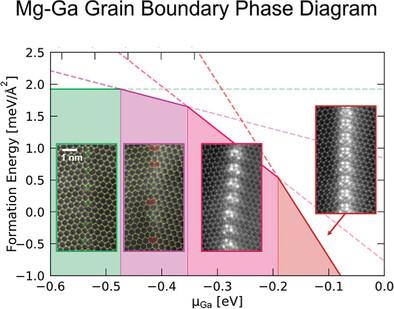当前位置:
X-MOL 学术
›
Adv. Mater.
›
论文详情
Our official English website, www.x-mol.net, welcomes your
feedback! (Note: you will need to create a separate account there.)
Materials Design by Constructing Phase Diagrams for Defects
Advanced Materials ( IF 27.4 ) Pub Date : 2024-11-17 , DOI: 10.1002/adma.202402191 Xuyang Zhou, Prince Mathews, Benjamin Berkels, Wassilios Delis, Saba Saood, Amel Shamseldeen Ali Alhassan, Philipp Keuter, Jochen M. Schneider, Sandra Korte-Kerzel, Stefanie Sandlöbes-Haut, Dierk Raabe, Jörg Neugebauer, Gerhard Dehm, Tilmann Hickel, Christina Scheu, Siyuan Zhang
Advanced Materials ( IF 27.4 ) Pub Date : 2024-11-17 , DOI: 10.1002/adma.202402191 Xuyang Zhou, Prince Mathews, Benjamin Berkels, Wassilios Delis, Saba Saood, Amel Shamseldeen Ali Alhassan, Philipp Keuter, Jochen M. Schneider, Sandra Korte-Kerzel, Stefanie Sandlöbes-Haut, Dierk Raabe, Jörg Neugebauer, Gerhard Dehm, Tilmann Hickel, Christina Scheu, Siyuan Zhang

|
Phase transformations and crystallographic defects are two essential tools to drive innovations in materials. Bulk materials design via tuning chemical compositions is systematized using phase diagrams. It is shown here that the same thermodynamic concept can be applied to manipulate the chemistry at defects. Grain boundaries in Mg–Ga system are chosen as a model system, because Ga segregates to the boundaries, while simultaneously improving the strength and ductility of Mg alloys. To reveal the role of grain boundaries, correlated atomic-scale characterization and simulation to scope and build phase diagrams for defects are presented. The discovery is enabled by triggering phase transformations of individual grain boundaries through local alloying, and sequentially imaging the structural and chemical changes using atomic-resolution scanning transmission electron microscopy. Ab initio simulations determined the thermodynamic stability of grain boundary phases, and found out that increasing Ga content enhances grain boundary cohesion, relating to improved ductility. The methodology to trigger, trace, and simulate defect transformation at atomic resolution enables a systematic development of defect phase diagrams, providing a valuable tool to utilize chemical complexity and phase transformations at defects.
中文翻译:

通过构建缺陷的相图进行材料设计
相变和晶体学缺陷是推动材料创新的两个重要工具。通过调整化学成分进行散装材料设计使用相图系统化。这里表明,相同的热力学概念可以应用于操纵缺陷处的化学性质。选择 Mg-Ga 系统中的晶界作为模型系统,因为 Ga 与晶界分离,同时提高了 Mg 合金的强度和延展性。为了揭示晶界的作用,提出了相关的原子尺度表征和模拟,以确定和构建缺陷的相图。这一发现是通过局部合金化触发单个晶界的相变,并使用原子分辨率扫描透射电子显微镜对结构和化学变化进行顺序成像来实现的。从头计算模拟确定了晶界相的热力学稳定性,发现增加 Ga 含量会增强晶界内聚力,这与延展性提高有关。在原子分辨率下触发、追踪和模拟缺陷相变的方法能够系统地开发缺陷相图,为利用缺陷的化学复杂性和相变提供了有价值的工具。
更新日期:2024-11-17
中文翻译:

通过构建缺陷的相图进行材料设计
相变和晶体学缺陷是推动材料创新的两个重要工具。通过调整化学成分进行散装材料设计使用相图系统化。这里表明,相同的热力学概念可以应用于操纵缺陷处的化学性质。选择 Mg-Ga 系统中的晶界作为模型系统,因为 Ga 与晶界分离,同时提高了 Mg 合金的强度和延展性。为了揭示晶界的作用,提出了相关的原子尺度表征和模拟,以确定和构建缺陷的相图。这一发现是通过局部合金化触发单个晶界的相变,并使用原子分辨率扫描透射电子显微镜对结构和化学变化进行顺序成像来实现的。从头计算模拟确定了晶界相的热力学稳定性,发现增加 Ga 含量会增强晶界内聚力,这与延展性提高有关。在原子分辨率下触发、追踪和模拟缺陷相变的方法能够系统地开发缺陷相图,为利用缺陷的化学复杂性和相变提供了有价值的工具。

































 京公网安备 11010802027423号
京公网安备 11010802027423号